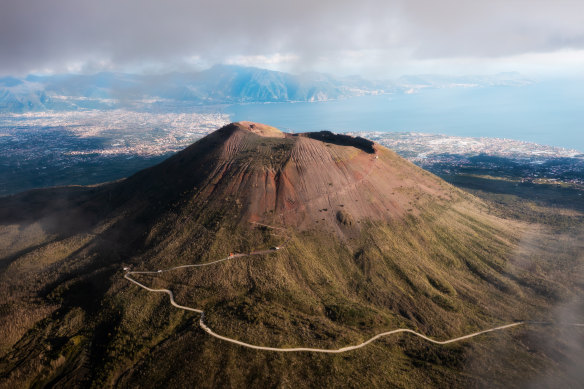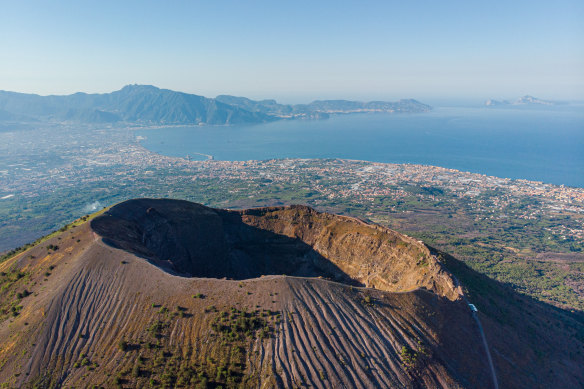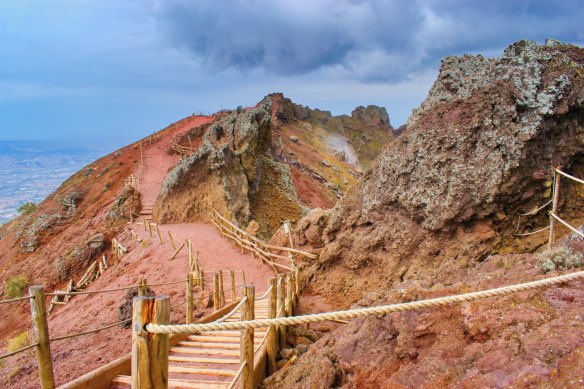It’s next to one of Italy’s most famous sites, but few visit this side
By Kurt Johnson
Ercolano station whips by, a blur of terracotta and graffitied concrete. We are supposed to be out there negotiating a bus ticket up Vesuvius, the only active volcano on the European mainland. Napoli’s low swagger demands local knowledge, which includes its public transport system of overlapping modes and companies. It’s a dialect we don’t speak, so we remain crammed among the armpits and steadying hands of tourists, squawking school children and their underpaid teachers.

Vesuvius, the only active volcano on the European mainland.Credit: Getty Images
At Pompeii we file out, running a gauntlet of hawkers. The next bus for Vesuvius leaves in 30 minutes, time to only glimpse the hollowed villas wrecked by the explosive eruption two millennia ago. The plan to cross from the volcano’s tourist-heavy front to the wild back country is entirely possible on maps, but nobody mentions achieving what seems entirely logical – catch a bus up and walk down. Any such gamble is made safer with more time and the sun is climbing.
The short bus zips up the incline and soon Napoli thins to villas in Vesuvius’s shadow, until all structures cease, replaced by balding scrub. The road of narrow switchbacks terminates at a carpark. Tourists file off yawning and stretching in the sulphurous alpine air. Below, Napoli crowds the gulf, glittering in the sun.

The crater rim walk provides views of Pompeii, Naples and beyond.Credit: Getty Images
Tourists queue at the stall-lined ticket gates. “Is it possible to get through to the other side?” I ask the inspector. “Yes. I will radio ahead. Speak to Silvano.”
The ground is gravel. My partner Barbara, a geologist, bends to touch. “It’s hot,” she says. It has the warmth of a living being. The path climbs then surrounds the crater’s edge, the roped-off far side falling to a sheer drop. The audio app provides commentary as we climb. In 1944, occupying American military witnessed the last eruption, a rising column of black smoke for once unrelated to war. Both Shelley and Byron wrote poems about Vesuvius. The world’s fastest animal, the peregrine falcon, uses rising columns of warm air from the crater in its yearly migration.

A hiking trail ascends to the crater of Vesuvius.Credit: iStock
At the crater’s edge, gawping tourists peer past the sharp lichen-encrusted rocks into the mouth: an immense pit of steaming gravel. Heat has melted gravel and ash into columns of solidified rock in the walls, Barbara explains. There are two types of volcanoes. Those in Hawaii are like a pot with no lid, where lava boils over and spills down the sides. The others are more like pressure cookers. Capped with rock, the pressure builds until the top explodes. Vesuvius began as the latter but the eruption that destroyed Pompeii blew off its lid, transforming it into the former.
The path leads around the crater’s rim and ends at a hut selling cheap wine, where a terrace peers over the drop to Sorrento. The vista’s otherworldliness is only a backdrop for most tourists who peer into phones, munch snacks or paw through souvenirs at stalls. A sign: “authorised access only” blocks the way onward. Beyond it’s neglected, with fencing tumbling down in parts. A man with a radio stands guard. “Are you Silvano? We’re looking to get through,” I say.

Discover landscapes devoid of humans within the national park.Credit: Getty Images
He grants us access to the national park and within minutes we are in a landscape empty of human life. The trail circles to the rear of the volcano, looking out above clouds of steam to the glittering bay and Capri. We enter the “valley of hell” and for the afternoon cross through vistas unlike any I have ever seen, landscapes that have been made, destroyed and remade.
While the budding spring flowers and birds that flitter among the tall pines show life’s resilience, implied is enormous violence and the suggestion that this is all temporary. Sometimes life shrinks to only scrub with steam rising from the hot gravel, at others full forest has avoided the last lava flow. Sometimes a mix where bone-white tree trunks stick above the scrub line like totems and the ground is of sharp black rocks that crunch like glass underfoot.
After hours we reach the outskirts of Ottaviano, marked by a towering castle once owned by the Medici family. I’m in a daze that lasts the entire rickety train ride back to the graffiti and surging life of Napoli.
The details
Fly
Naples International Airport is serviced by budget and major carriers. Naples is also a major train hub that can be reached within hours from most major Italian cities.
Visit
To get to Pompeii catch the Circumvesuviana train that runs between Naples and Sorrento.
Stay
Naples has a full range of accommodation options from five-star to budget. Choosing one in the Quartieri Spagnoli area will give you access to the centre, station and the port for onward trips to Capri.
The writer travelled at his own expense.
Sign up for the Traveller Deals newsletter
Get exclusive travel deals delivered straight to your inbox. Sign up now.